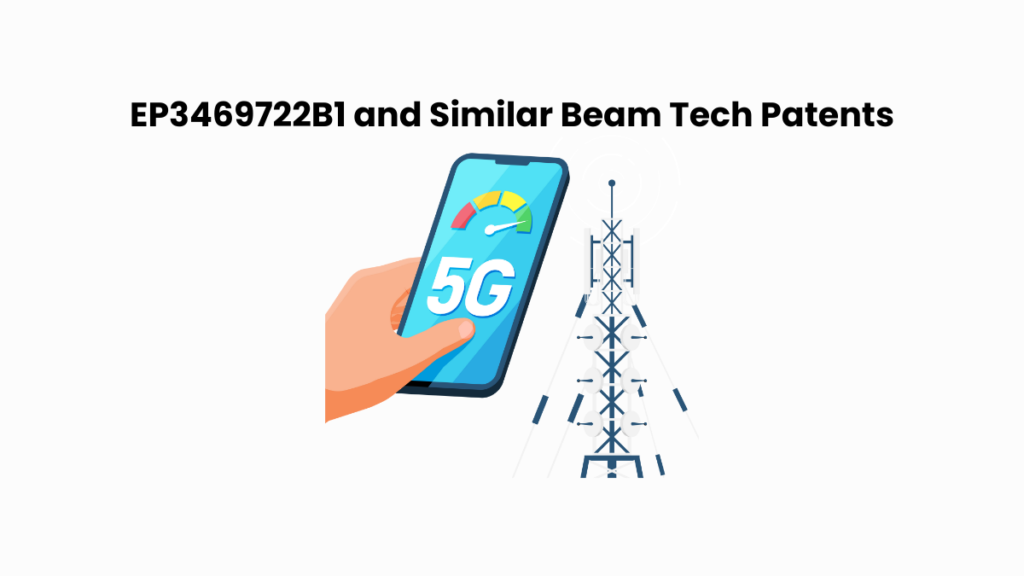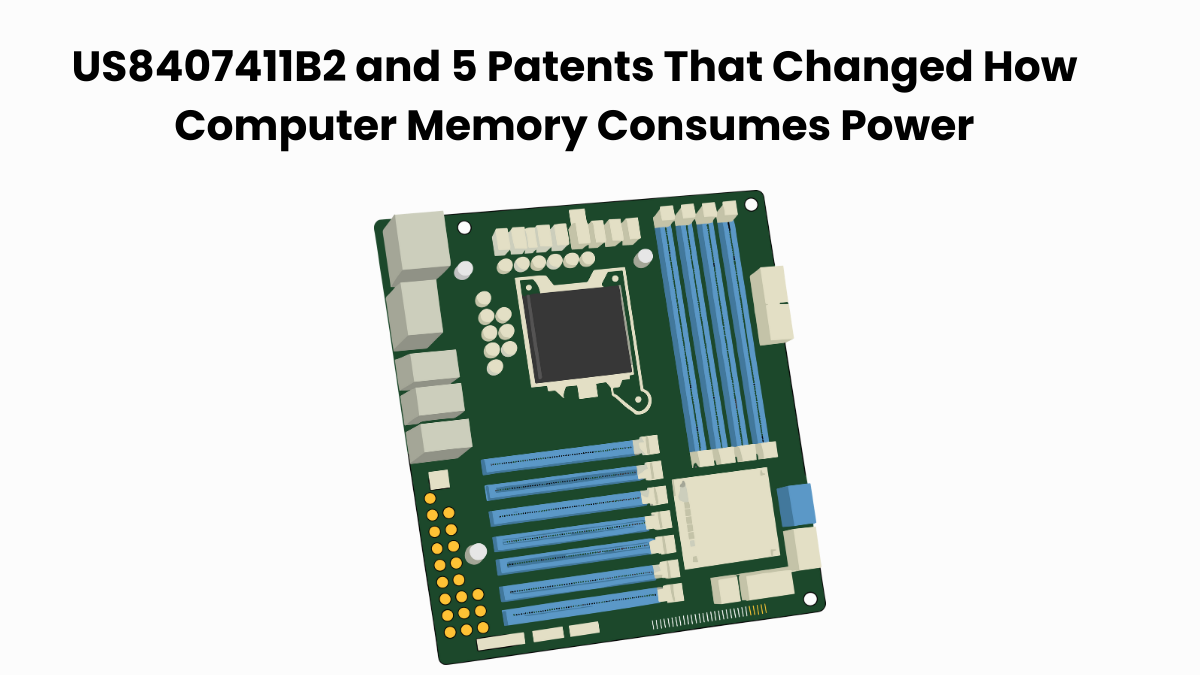When signal coordination meets next-generation connectivity, even a subtle protocol shift can reshape how networks handle data traffic.
EP3469722B1, assigned to MediaTek Inc., is one such patent, now at the center of an infringement proceeding involving Huawei Technologies. While the litigation is ongoing and filed across multiple jurisdictions, our focus here is strictly technical.
This European patent outlines a method in which mobile devices measure multiple signal beams and report back on performance across base stations. By using a pre-set number of beams from both serving and neighboring stations, the system enables smarter handovers and enhanced connection quality.
To surface related innovations, we use the Global Patent Search (GPS) platform. GPS excels at comparing patent features, identifying similar architectures, and overlapping implementations across wireless communication technologies.
Whether you are an IP strategist, standards researcher, or simply tracking advances in 5G and beyond, this GPS-driven analysis offers a precise lens on the design behind EP3469722B1.
Understanding Patent EP3469722B1
EP3469722B1 discloses a method and device for sending a measurement report in wireless communication systems. The invention focuses on beamforming environments, where mobile terminals interact with signal beams from serving and neighboring base stations. The system helps determine when to trigger a measurement event and whether to report signal strength or initiate handovers. This enhances connectivity performance and minimizes unnecessary switching.
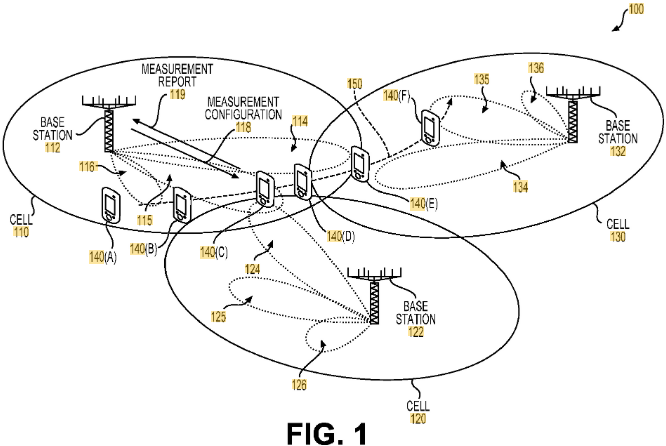
Source: Google Patents
Its Four Key Features Are
#1. Measurement event triggering: A mobile terminal receives a configuration message defining a measurement event based on a predetermined number of signal beams from both serving and neighboring base stations.
#2. Best beam selection: The terminal identifies and ranks the best signal beams, those with the highest quality, up to the defined number, based on real-time measurement.
#3. Dynamic thresholding: If too few beams exceed a set signal threshold, the system recalculates a new upper limit to ensure valid comparisons and decision-making.
#4. Reporting and handover decision: When the terminal meets specific measurement conditions, it sends a report or initiates cell reselection to support decisions such as intra-cell switching or handovers.
The patent addresses how mobile devices in a beamforming network intelligently evaluate signal quality across multiple beams. It plays a crucial role in optimizing wireless performance through more intelligent measurement and handover strategies. Seamless beamforming handovers rely on robust in-vehicle networks, as outlined in EP3726780A1 Patent Audit on In-Car Networking.
Similar Patents As EP3469722B1
To explore the innovation landscape surrounding EP3469722B1, we ran the patent through the Global Patent Search tool. Below is a quick glimpse of the GPS tool in action:
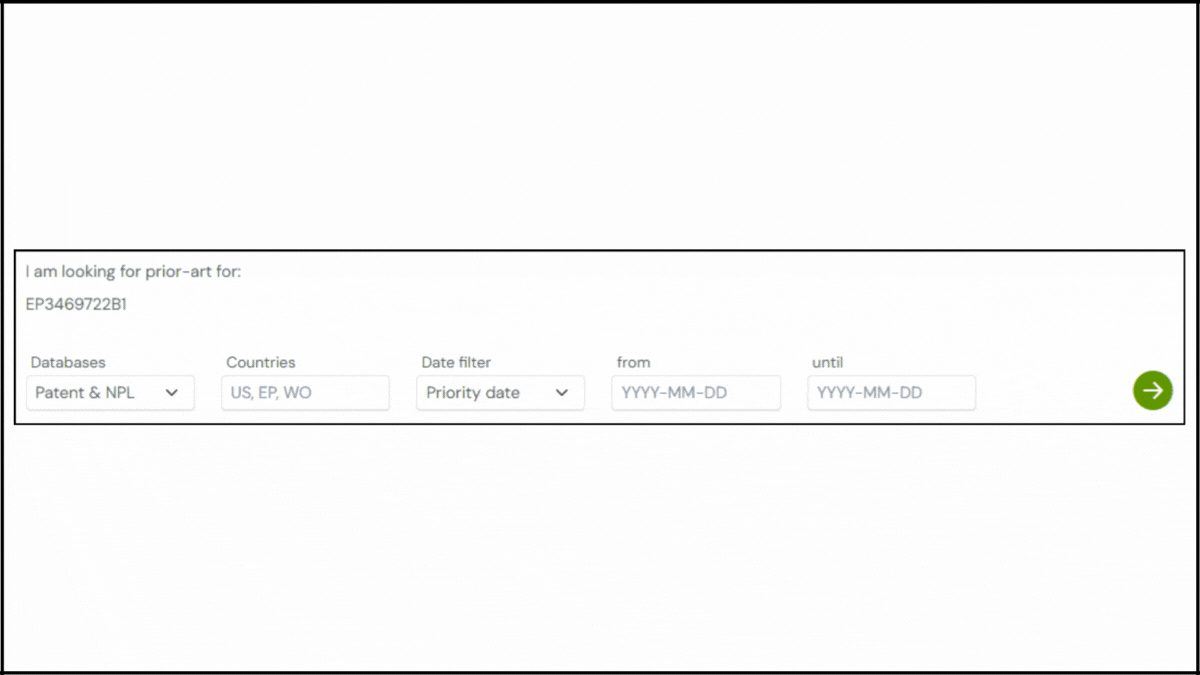
Source: Global Patent Search
This analysis surfaced a list of related patents that share technical similarities in beam measurement, mobility optimization, and signal reporting. Below, we highlight five of these references that reflect comparable ideas in managing communication across multiple beams. These examples offer insight into how engineers have addressed similar challenges in beamforming-based wireless networks.
#1. US2019159054A1
This US patent, US2019159054A1, published in 2019, outlines a two-step beam measurement and reporting framework for wireless networks operating in high-frequency (5G) environments. It allows a wireless device to first detect and report candidate beams and then provide detailed channel state information (CSI) on a refined subset configured by the network.
Below, we have added snapshots from the GPS tool highlighting the relevant snippets from the specification for the similar patents.
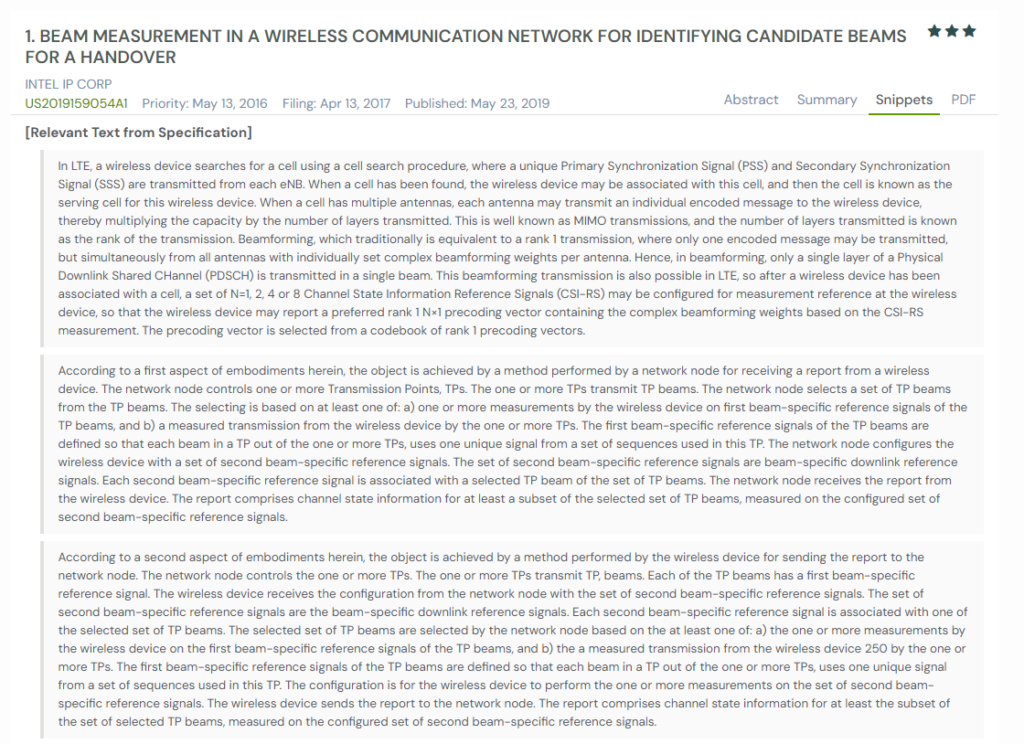
What Does This Patent Introduce To The Landscape
- Two-step reporting mechanism: Initial pre-reporting of candidate beams followed by focused CSI reporting on a selected subset.
- Beam-specific reference signals: The system assigns unique reference signals to each beam to enhance detection and measurement precision.
- Dynamic TP beam configuration: The network node selects beams based on device measurements and configures the reference signals accordingly.
- Mobility-aware signal tracking: Enables quick beam switching to maintain signal quality during movement.
- Group-based reporting: Restricts reporting to beams within the same transmission point or cluster to reduce latency and overhead.
- Uplink and downlink coordination: Allows both uplink and downlink reference signals to inform beam selection.
- Blind detection support: Supports synchronization and beam detection without prior configuration, useful during initial access or reselection.
How Does It Connect To EP3469722B1
- Both involve configuring the mobile device with a set number of beams for signal measurement.
- Each uses a ranked evaluation of signal beams to determine report-worthy candidates.
- Both reduce measurement overhead by limiting signal reporting to selected beams.
- The two patents share a focus on enhancing handover precision via controlled signal quality evaluation.
- Each supports decision-making for cell reselection or intra- and inter-cell beam switching.
Why Does This Matter
US2019159054A1 offers a robust, reference-signal-based architecture for beam detection and feedback. It aligns with EP3469722B1’s goal of intelligent beam selection while expanding on how reference signals and uplink coordination improve network efficiency and mobility responsiveness.
Smarter congestion handling aligns closely with beamforming. Patents such as EP3107243B1 make wireless networks handle congestion better through device-assisted policies that preserve capacity when demand spikes during mobility events.
#2. US2018049042A1
This US patent, US2018049042A1, published in 2018, outlines a hierarchical two-stage beam training and selection method involving a base station (BS) and user equipment (UE). Here, broad control beams are paired with finer, dedicated data beams. The system leverages anchor association indices to coordinate beam link identification and resource configuration across transmit and receive channels.
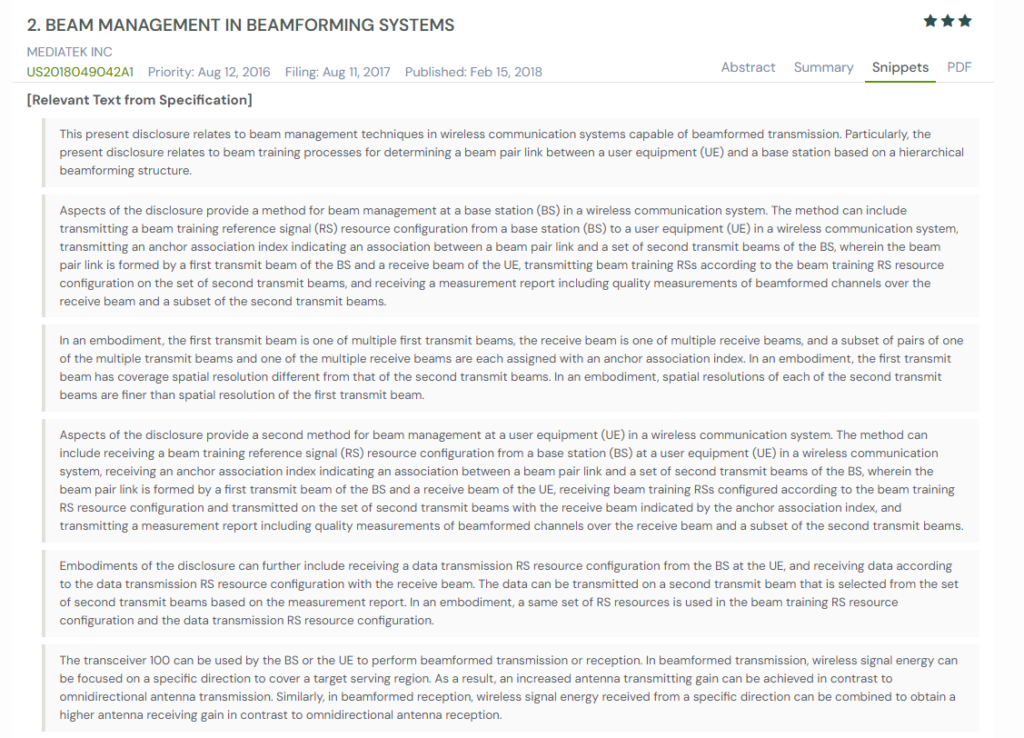
What Does This Patent Introduce To The Landscape
- Hierarchical beamforming structure: Distinct layers of control and dedicated beams with differing spatial resolutions to manage control and data transmissions efficiently.
- Anchor association for beam pairs: Mechanism linking control beams to dedicated beams through indices, allowing consistent beam selection and reuse of receive methods.
- Two-stage beam training: Initial control beam selection followed by refined measurement on dedicated beams for improved link quality.
- Configurable beam training resources: Use of beam training RSs to evaluate multiple beam pair combinations with high spatial precision.
- Implicit data beam switching: The UE continues to use predefined receive methods even if the BS changes the dedicated transmit beam, thereby reducing signaling overhead.
How Does It Connect To EP3469722B1
- Both patents implement multi-stage beam identification and optimization processes to refine UE-BS link quality.
- Emphasis on downlink beam measurement and reporting mirrors the use of reference signal-based feedback in EP3469722B1.
- The concept of beam pair quality evaluation closely parallels the candidate beam selection and switching logic in EP3469722B1.
Why Does This Matter
This hierarchical beam management design aligns with the broader goals of EP3469722B1 by enabling scalable, responsive beam selection strategies. It enhances spectral efficiency and device mobility while minimizing signaling complexity, core objectives in 5G and beyond.
Carrier coordination becomes even more reliable during mobility when the spectrum is aggregated. EP2525515B1 and 5 Related Patents in Carrier Aggregation Systems explain how uplink ACK/NACK timing and resource mapping strengthen feedback under carrier aggregation.
#3. CN104937972B
This Chinese patent, CN104937972B, published in 2019, proposes a method and device for adaptive signal measurement in a beamforming wireless system. It introduces dynamic grouping and reclassification of transmission/reception (Tx/Rx) beam pairs. This is based on metrics such as signal strength and signal delay. This allows the system to tailor measurement, reporting, and scheduling procedures to channel conditions.
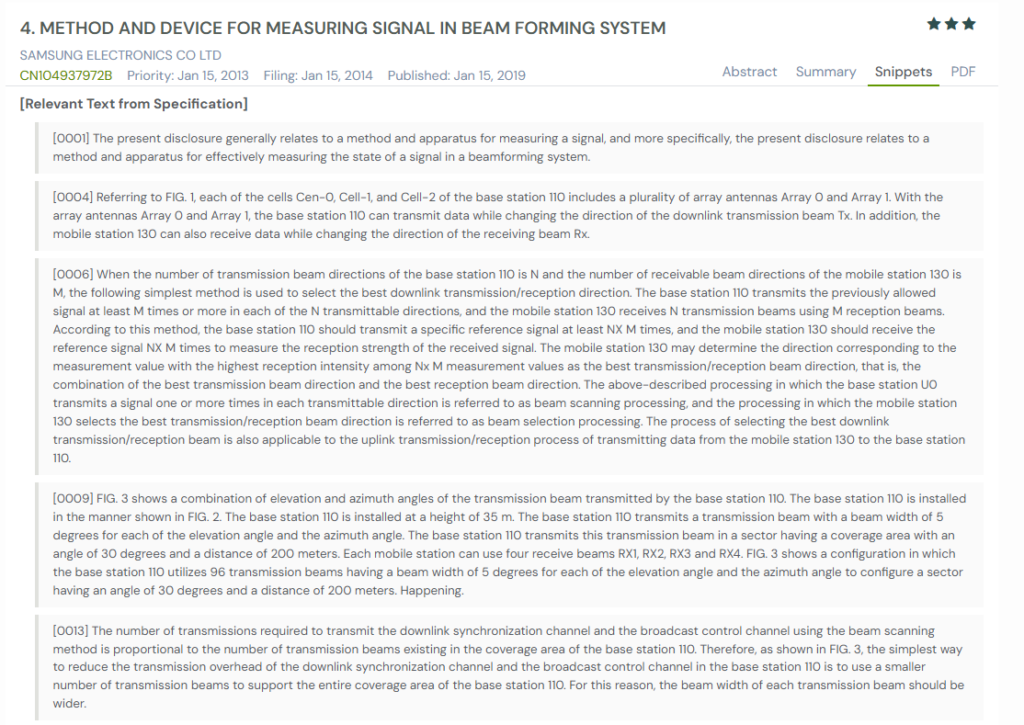
What Does This Patent Introduce To The Landscape
- Dynamic beam group classification: Beam pairs are grouped based on thresholds of signal strength or delay, enabling targeted measurement and reporting based on group priority.
- Group-based measurement rules: Each beam group (e.g., g1–g7) is assigned different measurement/report periods, methods (physical layer, MAC, signaling), and reporting detail.
- Threshold-driven beam reassignment: Beam combinations are dynamically reassigned to new groups as signal conditions change, optimizing resource use and scheduling relevance.
- Delay-based grouping logic: Signal delay is used in conjunction with strength to determine grouping, providing an additional layer of adaptability in beam selection and interference mitigation.
- Selective reporting mechanisms: More critical groups (e.g., g1–g3) are reported in detail, while lower-priority groups (e.g., g6–g7) are reported with simplified data.
How Does It Connect To EP3469722B1
- Both patents emphasize the fine-grained assessment of signal quality to guide beam selection and resource configuration.
- The use of reference signals across multiple beam combinations mirrors the technique described in EP3469722B1 for gathering link quality metrics.
- The concept of dynamic measurement and reconfiguration supports adaptive scheduling, similar to the candidate beam prioritization in EP3469722B1.
Why Does This Matter
The use of beam group thresholds and differentiated measurement rules provides a scalable solution to managing large numbers of directional beams. This approach complements EP3469722B1 by supporting enhanced measurement efficiency. It also supports intelligent scheduling based on varying channel conditions and user-specific beam dynamics.
#4. MX383624B
This Mexican patent MX383624B, published in 2021, describes a method and device for sending a measurement report in a wireless communication system. The technique involves measuring multiple signal beams, both from the serving base station and neighboring base stations. The best-performing beams up to a predefined number are selected, and measurement reports are triggered when specific event criteria are met. The criteria include signal quality thresholds or comparisons between serving and neighboring beams.
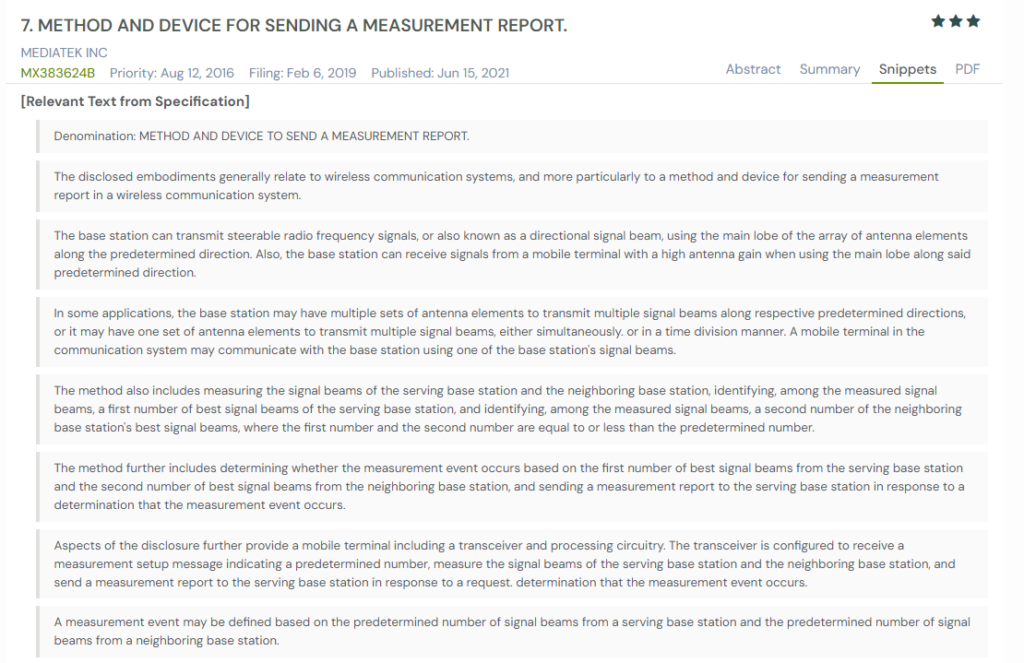
What Does This Patent Introduce To The Landscape
- Cross-cell beam evaluation: Incorporates signal beam measurements from both serving and neighboring base stations, offering a broader context for decision-making.
- Predetermined beam count logic: Limits the number of beams from each base station considered (serving and neighbor) based on a configurable maximum.
- Measurement-event trigger mechanism: A measurement report is sent only when defined criteria, like signal thresholds or quality comparisons, are satisfied.
- Adaptive threshold adjustment: Includes logic for adjusting thresholds or the number of beams (e.g., to N’) when fewer qualified beams are detected.
- Support for beam quality comparison metrics: Evaluates metrics like signal strength, SNR, and measurement offsets to determine which base station’s beams should trigger reports.
How Does It Connect To EP3469722B1
- Both patents center on selecting and reporting on a limited set of best-performing beams, refining the set of candidate beams for triggering network decisions.
- They each use signal quality thresholds and ranking logic to manage which beams are considered and when measurement or reporting should occur.
- The method of comparing beams from serving and neighboring base stations in MX383624B mirrors EP3469722B1’s multi-beam evaluation for performance-based decision-making.
- Both approaches aim to improve measurement efficiency, reducing unnecessary overhead while enabling prompt reactions to changing signal conditions.
Why Does This Matter
MX383624B highlights a flexible and event-driven approach to beam-based measurement reporting within multi-cell environments. Its mechanisms prioritize the most significant beams, applying dynamic thresholds and evaluating cross-cell signal quality. This contributes to smarter handover strategies and network resilience, clear enhancements for beamforming systems in evolving wireless standards.
#5. CN112040509A
This Chinese patent, CN112040509A, published in 2020, describes a method and device for measuring and reporting beam state information in beamforming-based communication systems. It addresses both measurement inefficiencies and reporting logic in multi-beam wireless architectures by introducing normalization processes, priority rules, and trigger conditions. The invention ensures that both serving and neighboring cell beams are measured and reported based on filtered averages and predefined thresholds. This improves the responsiveness and precision of beam-based handovers.
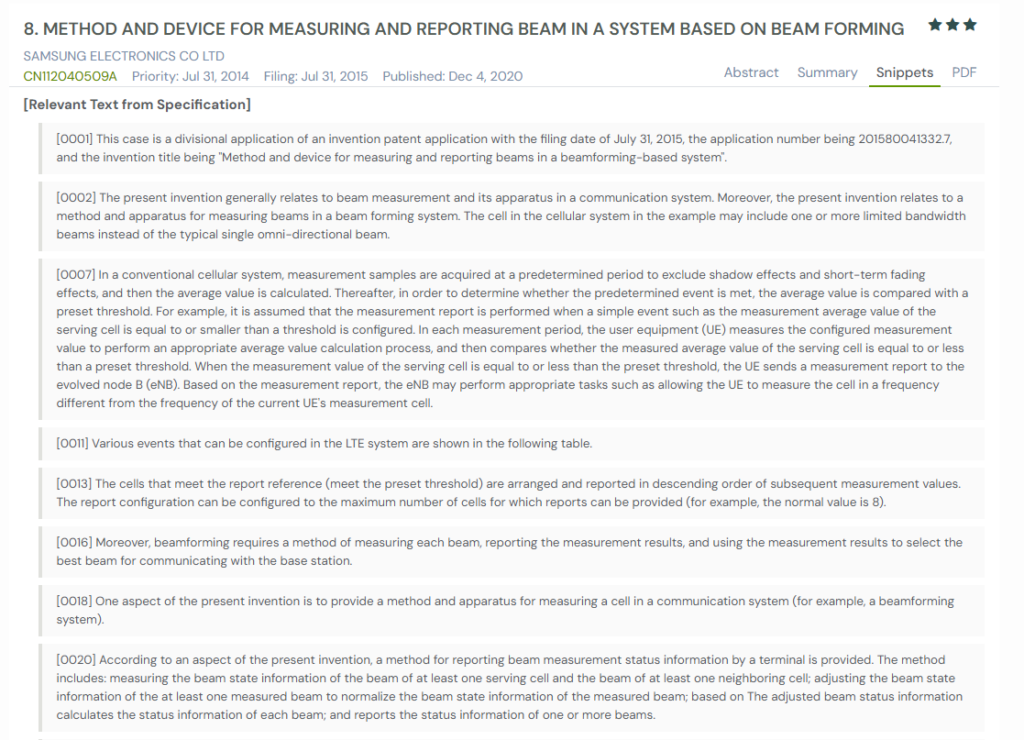
What Does This Patent Introduce To The Landscape
- Normalized beam measurement reporting: Adjusts raw beam state information before reporting, compensating for unequal sample sizes and enabling accurate comparisons.
- Dual RX-chain architecture: Enables separate measurement of serving and neighbor beams using parallel reception paths, enhancing multi-cell beam awareness.
- Beam-based reporting triggers: Defines conditions for triggering reports—such as beam averages falling below or above thresholds, or relative performance between neighboring and serving cells.
- Cell and beam priority logic: Introduces mechanisms to rank cells based on beam pair quality or average signal condition, allowing targeted and efficient beam reselection.
- Sample-weighted reporting strategy: Applies recent-priority weighted averages (RPWA) to give more relevance to the latest signal conditions and reduce outdated influence.
How Does It Connect To EP3469722B1
- Both focus on selective reporting based on beam performance, refining when and how reports are generated in dense beamforming scenarios.
- CN112040509A introduces dual RX chains and cell priority logic, complementing EP3469722B1’s mechanisms for beam quality comparison and event-triggered measurement reports.
- Each patent seeks to reduce power consumption and processing overhead by limiting when and which beam data is used for reporting and handover decisions.
- They both emphasize efficient beam pair management in high-density network environments to ensure responsive mobility handling.
Why Does This Matter
In modern 5G and beyond networks, beam-based architectures introduce immense complexity in measurement and reporting. CN112040509A provides a detailed and adaptable framework for addressing that complexity. This includes sample weighting, reporting triggers, and cell prioritization. These techniques directly enhance the responsiveness and efficiency of mobility decisions, reduce UE burden, and enable smarter beam selection. All of this aligns with the core goals of EP3469722B1.
These adaptive methods echo broader industry trends in Edge AI, where real-time decision-making happens closer to the device.
How to Find Related Patents Using Global Patent Search

Understanding the broader patent landscape is key when tackling beam-based handovers, signal measurement strategies, or mobility optimization in wireless networks. The Global Patent Search tool streamlines this process, helping users identify systems that reflect similar beam tracking, event-triggering, or dual-chain reporting mechanisms.
1. Enter the patent number into GPS: Start by entering a patent number like EP3469722B1 into the GPS tool. The platform transforms it into a smart query, which you can refine using terms like beam measurement, event trigger, or signal quality thresholds.

2. Explore conceptual snippets: Instead of comparing features claim-by-claim, GPS now offers curated text snippets. These highlight how other systems handle serving vs. neighbor beam evaluations, define handover criteria, or adjust reporting thresholds dynamically.
3. Identify related inventions: The tool reveals patents that manage beam selection, determine measurement events, or report signal status based on mobility patterns, showing how similar challenges have been solved across architectures.
4. Compare systems, not legal claims: Rather than focusing on formal legal language, GPS compares system behaviors. This allows users to trace functional overlaps in how measurements are filtered, averaged, or prioritized for decision-making.
5. Accelerate cross-domain insights: Whether you are working on 5G beamforming, mobile device protocol, or wireless infrastructure coordination, GPS helps uncover related approaches that may otherwise remain siloed by terminology or filing region. This is also evident in emerging domains like smart grid communication networks, where similar architectural thinking applies.
With this approach, Global Patent Search provides network engineers, mobility specialists, and IP teams with a structured, concept-first method for exploring beam-focused technologies and informing more effective handover and measurement strategies. For those expanding their research beyond GPS, here is a curated list of free patent search databases worth exploring.
Disclaimer: The information provided in this article is for informational purposes only and should not be considered legal advice. The related patent references mentioned are preliminary results from the Global Patent Search tool and do not guarantee legal significance. For a comprehensive related patent analysis, we recommend conducting a detailed search using GPS or consulting a patent attorney.

